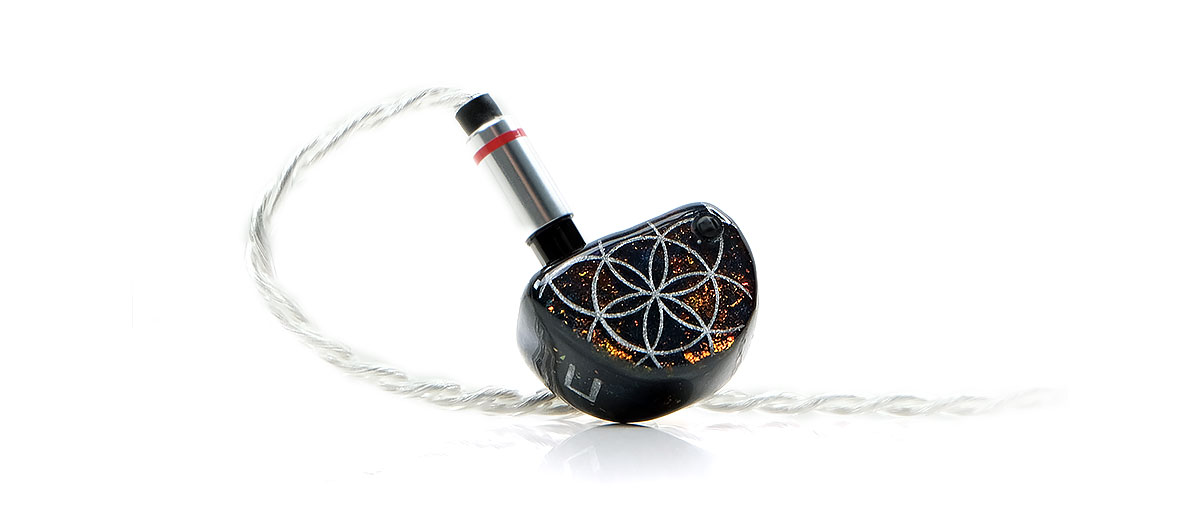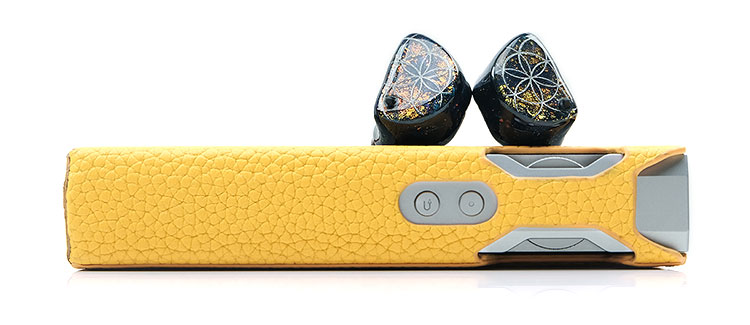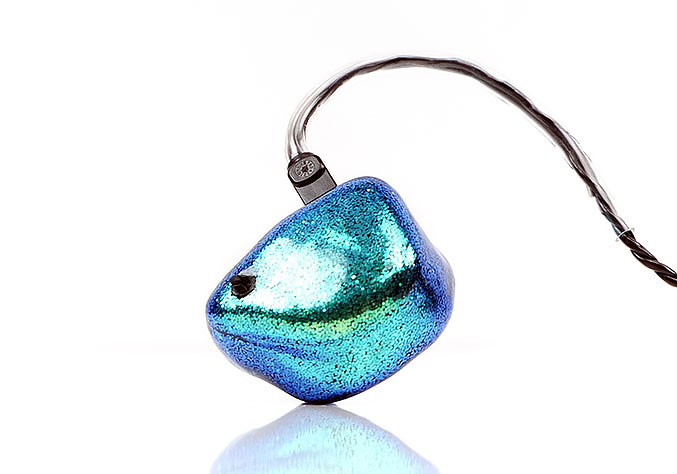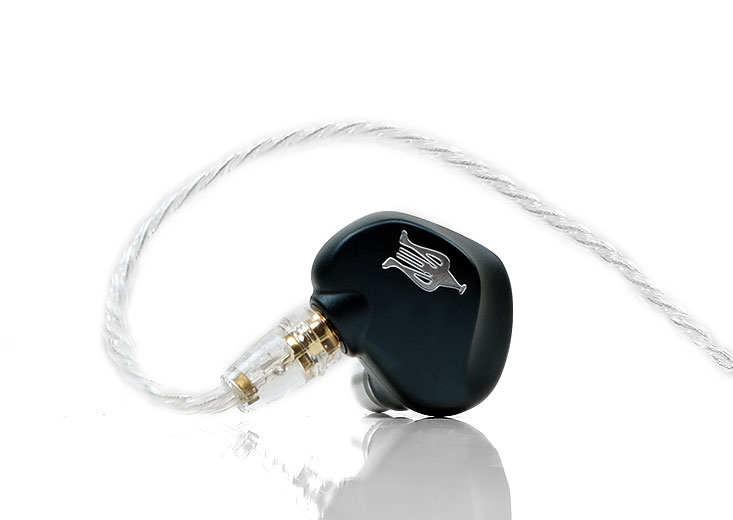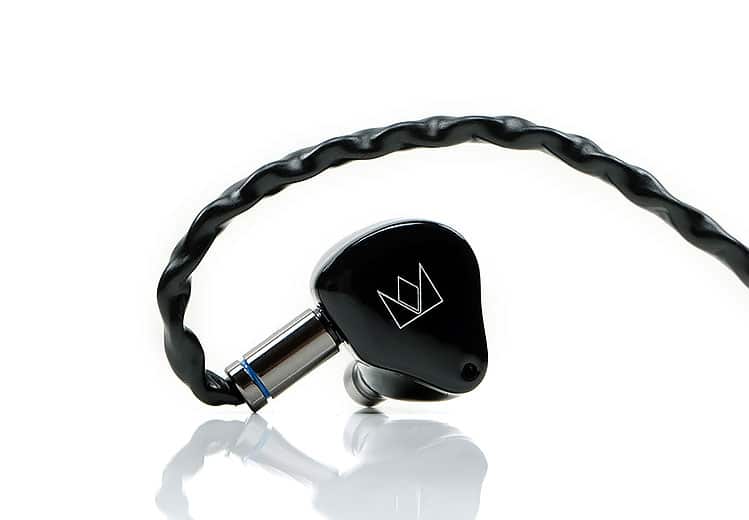Sound Impressions
Summary
The Pneuma may just be the surprise of the year for me with a tuning that is just dripping in enjoyable PRaT yet technically competent enough to keep the detail flowing in abundance at the same time.
The response curve does not tell the full story here for me with its lightly applied “W-shape” and heavy emphasis on low-end rumble combined with a nicely balanced vocal presence and lower-treble energy.
The Pneuma manages to sound smooth and very enjoyable yet surprisingly detailed at the same time. Especially in terms of staging with superb width and instrumental separation without having to resort to necessary treble heat to achieve that sense of clarity.
With the bass boost turned on the Pneuma FR takes a 4-5dB boost from 20-100Hz over its non-boosted position pushing the sub-bass a little higher in presence than its midrange 2-3k bump which is largely unaffected by this targeted boost.
Because the boost is primarily focused on the absolute low-end, with an increasing dB attenuation from 100Hz to around 500Hz, the mids remain refreshing clean from bloom.
Delicate vocals such as falsetto or light chest voice techniques sound resolutely clear and vivid with just the right harmonic balance. That control on the bloom from the dual BA bass drivers means the Pneuma is blissfully free from overly warmed up, rounded, and dull or slow sounding notes.
I have to say I much prefer keeping the bass switch on with the Pneuma. Granted keeping it off brings a bit of audiophile sensibility to the tuning but it loses a bit of ‘Joie de vivre’ and to be frank, it does not seem to jive as well with how Lime Ears described their ‘bad intentions’ with the Pneuma.
Timbre
Whilst not quite as liquid as the Aether R, the harmonic balance in the Pneuma timbre is delightfully engaging and easy on the ear to be perfectly honest.
Granted, there is more of a contrasty feel to instrumental and vocal timbre with some nice power and light warmth right at the low-end combined with a smattering of treble sparkle coming into the more prevalent BA texture in the upper mids and lower treble.
Beyond 1-2k body does thin out a little but not to the point where texture is non-existent, more of a sweet and light tone than a thick and rich delivery.
A little bit of upper treble fade beyond 5k seems to have done the trick here to ensure the BA driver timbre is not strained and necessarily clashing with the dynamic driver’s more languid tone to create that sweetness.
Staging
I love the staging capability of the Pneuma. It’s heavy on depth with the boost switch on but light on the bloom with excellent layering and clarity. The smaller dynamic driver is reasonably quick and tight sounding, which, combined with the pacey dual BA bass drivers helps a lot in that regard.
More than that is the excellent width and instrumental separation making some competing 5-driver hybrids sounds relatively compressed or overly center-focused. The Pneuma has a solid bump in the mids around 1-3k that also stretches the stage from front to back only serving to add to a strong perception of an impressively holographic soundstage.
Quite often, tunings that aim for a high degree of coloration and high-contrast signatures overly emphasize the bass and treble to get that vivid sound. In doing so the mids can often come across as narrow, vague, or lacking in presence. Not so with the Pneuma. The mids are very vivid and clear with an impressively black background.
Treble energy is just a little faded beyond 5k so its focus centers just a little more on the interplay between that dynamic low end and forward upper mids and lower-treble but it is not lacking in headroom or air at all.
Synergy
Efficiency
Lime Ears have not released any impedance and SPL data for the Pneuma which is consistent with all of their monitors so it really boils down to some simple real-world testing to get a feel for its efficiency levels.
Compared to the Aether R, the Pneuma sounds marginally less sensitive but not by much. Going balanced with both out of the HiBy R8 you just get the faintest hiss on low volume on the Aether R compared to the Pneuma but it is very low.
The Rai Penta is rated at 20Ω and 110dB SPL and whilst we do not have an official rating for the Pneuma our testing indicates that it sounds a bit more dynamic and marginally louder at similar volume rates (60, low gain, Lotoo PAW Gold Touch).
Neither monitor has problems with sources with higher noise floors so they are very quiet on unbalanced DAP outputs such as the FiiO M15 and the HiBy R8. There was a little bit more noise going balanced but not pervasive.
The Pneuma is also more sensitive compared to Noble Audio’s Tux 5 5-driver hybrid which is another unrated IEM. We did test both using the same PW Audio No 10 cable to ensure no cable resistance issues affected the outcome. Neither are sensitive to hiss on our tested sources and that included going balanced with the E02 motherboard on the Cayin N6ii.
Pairings
I actually much preferred pairing the Pneuma in balanced mode with more neutral DAPs. Sources that are neutral in timbre with a punchy and highly detailed performance to be precise.
That includes the iBasso DX220 MAX, Lotoo’s PAW Gold Touch, and FiiO’s M15. The Pneuma’s excellent layering and staging width seem to come alive more on these DAPs than warmer or more liquid-sounding alternatives such as the HiBy R8.
There were some inbetweeners that bucked that general bias but more due to some inherent traits they offer than any general tonal preference. The E02/N6ii pairing is known for a very high level of channel separation when going balanced and for me, the Pneuma really enjoys that type of technical trait in any source.
The other exception was the Luxury and Precision P6 R2R DAP and more for how it took a little of the delta-sigma shine out of the Pneuma’s notes and injected a lot of beautiful detail in the dynamic river and bass BA driver’s performance.
I would still hesitate to fully recommend this pairing because it is not as expansive sounding as the first 3 options mentioned from the mids upwards.
Select Comparisons
Lime Ears Aether R
€1,200
Technical
“The King is dead, long live the king”. For so many years, the Aether R was the TOTL monitor at Lime Ears and now, whilst still available, it is the No 2 in their product lineup. This is a 6 BA configuration rather than a hybrid but the split, as with the Pneuma is not standard fare.
The sub/low is split via an acoustical crossover (namely TrueSub) and the split between lows/mids/highs is achieved via an electrical crossover. Thus, the configuration is a ‘double’ subwoofer, ‘double low’, single mid BA, and a single high BA.
The Pneuma also has its clever config with the 7mm dynamic focused purely on the sub-bass response and the continued use of a ‘double’ low for the mids to upper bass into the lower-mids, single mid BA, and a single high BA.
Both do share VariBore designs with bass switching tech though the Pneuma is a little more wide-ranging at 3-6dB compared to around 3-4dB for the Aether R. The Aether R also uses BA-specific tech from Lime Ears including their TrueSub for acoustical treatment whereas Pneuma uses their new BAM for similar purposes.
Design
One is a custom and the other is universal so aside from both being acrylic shells, there are quite a few differences. here I recommend you grab the Pneuma custom if you want the ultimate in fitting and isolation as the custom Aether R is perfect and does block out noise more than the universal Pneuma.
I will say though, as much as I think the Scarabeus design of the Aether R is cool, the trans ref flake design of the Pneuma is more my thing so brownie points there. Both are 2-pin 0.78mm cable connected though the Aether R has a more generic 4-wire OFC cable and not the excellent PW Audio No 10 cable.
Performance
The Aether R is not the Pneuma sans dynamic driver although there are some similarities in terms of being more to the musical side than analytical.
Bass & Mids
The dynamic driver does make a fair bit of difference to the tone and weight of the Pneuma with the distinct BA texture of the mid-bass orientated Aether R being replaced by the great power and more natural-sounding decay of the Pneuma dynamic driver.
The dB swing of the Pneuma bass switch is also more substantial and more focused when turned on compared to the more subtle tuning of the equivalent switch on the Aether R. You get a subtle lift on the Aether R’s low-end compared to a heavier rumble from the Pneuma.
Because the Aether R is a little bit more mid-bass punch than the sub-bass rumble the transition into the lower mids is a little smoother with a bit more instrumental presence and warmth. The Pneuma has more of a dip, a bit more bass to mids separation, and a comparatively cleaner but high-contrast tone in the same region.
Vocals on the Aether R do sound the more forward of the two though the vocals on the Pneuma are by no means neutral or dipped just not as prominent. Rather, the Aether R’s less prominent bass response allows the vocals to take more of center stage presence.
Treble
Treble tuning on these are different and in turn, I find the timbre in the upper mids a bit different also. The Aether R has a significantly less lower-treble presence and a bit more upper treble elevation around the 8k marker.
The Pneuma has a more coherent but elevated lower-treble tuning with a tamer dip around 4k and a natural fade beyond 7k. You might detect a little more brightness in the upper mids of the Pneuma but it’s not obvious as the bass warmth acts as a really nice counterweight.
The Aether R might actually sound a little smoother because of the more controlled bass response with the bigger dip in the upper mids taking the sting out of that 8k peak.
Meze Rai Penta
$1099
Technical
The Rai Penta is a little bit cheaper than the Pneuma but it does have a similar configuration as a hybrid universal monitor. Inside, you get a single using a single 10mm dynamic driver and a quad balanced armature setup.
I am presuming a 3-way crossover with the dynamic driver for the lows and 2 BA for the mids and 2 BA for the highs as Meze does not go into detail on the split. This is compared to Lime Ear’s more focused use of the smaller 7mm for sub-bass and a dual bass BA for the mid-bass to lower-mids and then a single BA for the mids and one more for the highs.
Both monitors have their respective proprietary tech with the Rai Penta using a PES or Pressure equalizing system with dual venting in the front and behind the driver assembly to allow the dynamic driver plenty of room to breathe. The Pneuma does not require the same level of venting for its 7mm but it does use its BAM system for resonance control in the chamber.
The two monitors do have a focus on their tubing systems but with a different approach. The Rai Penta has a precision-milled sound bore design that uses variable-length steel tubes instead of silicone or plastics to control the airflow. This is to correct or harmonize phasing to produce a cleaner more precise level of sound going to your ear.
The Pneuma uses their VariBore tech on their tubing which is a variable bore sizing to control the type of signal produced. The larger openings lowering the level of resonance and tighter openings enhance the low-end presence.
Design
Both monitors have attractive designs but from very different perspectives. The Rai Penta has a smooth dark blue CNC-sculpted aluminum housing with nuanced curving and a beautiful anodized finish.
The Pneuma has a bolder trans-red flake finished heavily contoured acrylic shell design with that tiny bass switch at the base of the faceplate. One is subtle the other is high-impact in their aesthetics.
The Rai Penta does have a significantly smaller form factor with its PES venting system so whilst it is lighter in the ear and sits a bit flusher than the Pneuma it does not isolate as well. A combination of less forgiving aluminum, less contouring, and the bass port means passive noise isolation is weaker.
The Rai Penta is also MMCX terminated compared to a 2-pin 0.78mm on the Pneuma and its stock cable, balanced or otherwise, has a smaller gauge. It is lighter, nicely finished but a little more resistive with a lower level of dynamic range compared to the bigger wired PW Audio No. 10.
Performance
In terms of pure FR differences, the Rai Penta’s big diversion is really on the amount of bass elevation and that sub-bass tuning. The Rai Penta has a moderate level of a bass kick in that dynamic driver with a controlled level of power compared to the bass-on switch of the Pneuma which has a greater level of sub-bass extension and presence.
With the bass switch off on the Pneuma, the bass response curve is closer to the Rai Penta in terms of physicality and quantity with maybe a little more warmth in the mid-bass of the Rai Penta.
Both monitors have a dip in the lower-mids and a reasonably forward vocal presence and a fairly natural-sounding treble tuning. If anything, the Pneuma has a bit more kick in its treble energy and a bit more odd-harmonic presence in its midrange timbre but nothing dramatically different in terms of tone. Both have a very nice balance with excellent timbre in that regard.
Where the real differences are between these two is the dynamic range performance and level of instrumental separation. This is where the Pneuma earns its higher price tag.
The Pneuma sounds more holographic to my ears, especially with the bass switch turned on. The level of clarity is a step up on the Pneuma with a much wider and taller soundstage. When I say taller I do not mean more treble, I mean headroom, air, and overall separation into the mids.
The Rai Penta is much more center-focused and intimate by comparisons with a flatter staging quality and less comparative depth and air. It is quite a different technical performance and will appeal more to those who may want something a bit more relaxed in its delivery.
Noble Audio Tux 5
$1300
Technical
Again, slightly on the cheaper side, but also again, a similar hybrid 5 driver offering. The Tux 5 is a single 10mm dynamic driver with 4 Knowles BA.
The overall configuration for the BA drivers is two for the mid-low frequencies, and two for the mid-high frequencies. That leaves the 10mm, dynamic driver, free to focus on the lows. The grouping would indicate dual-driver Knowles and a 3 or 4-way crossover configuration.
The Pneuma uses that smaller 7mm driver for the sub-bass and a dual bass BA config for the mids-bass to lower-mids, then a single BA for the mids and a BA for the highs.
Design
The phrase Tux is short for Tuxedo hence the Tux 5 is a plainer black hollow body acrylic shell with Noble’s logo and symbols in white on the faceplates.
In truth, the Pneuma design is much more striking and complete but I do appreciate some users like to keep it plain and simple so horses for courses here. My own opinion is that the Pneuma has been given more design investment time and an exotic blend of materials that do capture your eye a bit more.
The Tux 5 is a smaller monitor with a more compact form factor with similar contouring designed to fit snugly into your ear. Because of that, it is a little lighter in your ear than the Pneuma and also flusher to the ear when not using the largest foam tips which push it out a little.
Both use 0.78mm 2-pin sockets and both come with excellent cables. The stock cable on the Tux 5 is a 1.2m 8-core OCC copper wire in a nice two-tone FEP or PVC jacket and I presume 26AWG. The No 10 on the Pneuma is a higher rated 24AWg but a 4-core single crystal OCC SPC.
The two cables are big but handle really well with some excellent finishing and look beautiful. However, I give a slight edge to the No 10 cable from the Pneuma package as it does not use memory wire. The Tux 5 memory wire is a little bit on the long and bulky side which adds a bit of stiffness to the handling but nothing major.
Performance
For a closer comparison of these two monitors, the Pneuma bass switch is turned on because the Tux 5 has a more aggressive U or possibly V-shaped response curve with plenty of sub-bass elevation.
The Pneuma bass boost turned on has some nice elevation and sub-bass extension also but less extreme in terms of quantity and overall a better balance through the midrange.
The mids on the Tux 5 are dipped more heavily into the lower-mids with only a gentle rise from 1-4k. That is just enough for vocal clarity but the effect is a far-field speaker-like presentation or a more grand but diffuse affair for midrange positioning. Vocals will seem more distant, with less impact as also instrumental note body being a little thinner.
The Pneuma also dips a little into the lower-mids but the midrange bump is more pronounced from 1-4k with better instrumental and vocal presence as well as a little more warmth. It sounds more immediate and engaging through the midrange compared to the Tux 5.
The Tux 5 treble is a little peppier from 5-8k compared to the more natural fade of the Pneuma as you would expect given the amount of low-end heft. That does mean the Tux 5 is more of a high contrast type of presentation with more emphasis on bass fundamental power and treble crispness and less textural warmth.
The Pneuma also has some nice contrast not as lean through the mids with a gentler treble presence. You could argue the Tux 5’s FR emphasizes a bit more depth and height in terms of energy but the Pneuma is more complex and wider through the mids with a more forward vocal presence.
Our Verdict
I think Lime Ears have a bit of a hit on their hands with the beautifully styled universal flagship Pneuma. This is a monitor with a very nice technical capability, particularly with staging, and fused with some very enjoyable bloom-free, PRaT heavy coloration.
The Pneuma offers the type of modern tuning that works wonderfully well with rock, pop, and R’n’B. It also offers a more vivid choice to the previous flagship, the relaxed sounding all-BA Aether R.
Go with the bass switch on the Pneuma, keep it on, and glue it there if you have to. Yes, it is more audiophile with the bass switch off but honestly, this is not meant to be an analytical experience. It is far more enjoyable if you take the proverbial handbrake off.
Lime Ears Pneuma Specifications
- One titanium dynamic driver for sub-bass
- Four balanced armature drivers
- Four-way passive hybrid crossover
- Switchable subwoofer dynamic driver
- Utilizing VariBore
- BAM technology

